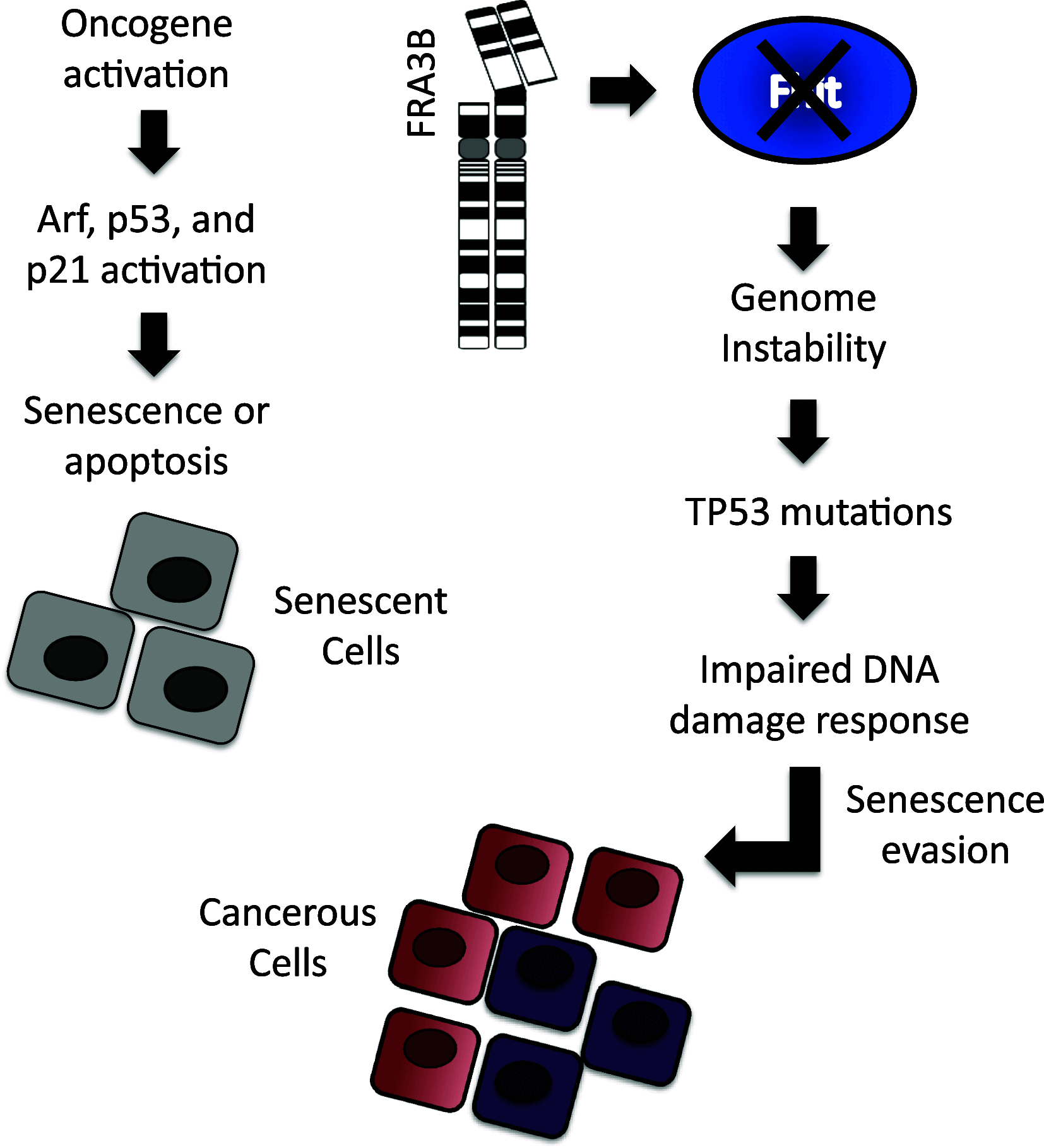The FHIT gene product: tumor suppressor and genome "caretaker"
- PMID: 25283145
- PMCID: PMC4233150
- DOI: 10.1007/s00018-014-1722-0
The FHIT gene product: tumor suppressor and genome "caretaker"
Abstract
The FHIT gene at FRA3B is one of the earliest and most frequently altered genes in the majority of human cancers. It was recently discovered that the FHIT gene is not the most fragile locus in epithelial cells, the cell of origin for most Fhit-negative cancers, eroding support for past claims that deletions at this locus are simply passenger events that are carried along in expanding cancer clones, due to extreme vulnerability to DNA damage rather than to loss of FHIT function. Indeed, recent reports have reconfirmed FHIT as a tumor suppressor gene with roles in apoptosis and prevention of the epithelial-mesenchymal transition. Other recent works have identified a novel role for the FHIT gene product, Fhit, as a genome "caretaker." Loss of this caretaker function leads to nucleotide imbalance, spontaneous replication stress, and DNA breaks. Because Fhit loss-induced DNA damage is "checkpoint blind," cells accumulate further DNA damage during subsequent cell cycles, accruing global genome instability that could facilitate oncogenic mutation acquisition and expedite clonal expansion. Loss of Fhit activity therefore induces a mutator phenotype. Evidence for FHIT as a mutator gene is discussed in light of these recent investigations of Fhit loss and subsequent genome instability.
Figures


Similar articles
-
Mechanisms shaping the mutational landscape of the FRA3B/FHIT-deficient cancer genome.Genes Chromosomes Cancer. 2019 May;58(5):317-323. doi: 10.1002/gcc.22684. Epub 2018 Nov 18. Genes Chromosomes Cancer. 2019. PMID: 30242938 Review.
-
Fragile Genes That Are Frequently Altered in Cancer: Players Not Passengers.Cytogenet Genome Res. 2016;150(3-4):208-216. doi: 10.1159/000455753. Epub 2017 Feb 16. Cytogenet Genome Res. 2016. PMID: 28199992 Review.
-
Common chromosome fragile sites in human and murine epithelial cells and FHIT/FRA3B loss-induced global genome instability.Genes Chromosomes Cancer. 2013 Nov;52(11):1017-29. doi: 10.1002/gcc.22097. Epub 2013 Aug 9. Genes Chromosomes Cancer. 2013. PMID: 23929738 Free PMC article.
-
Initiation of genome instability and preneoplastic processes through loss of Fhit expression.PLoS Genet. 2012;8(11):e1003077. doi: 10.1371/journal.pgen.1003077. Epub 2012 Nov 29. PLoS Genet. 2012. PMID: 23209436 Free PMC article.
-
Fhit and Wwox loss-associated genome instability: A genome caretaker one-two punch.Adv Biol Regul. 2017 Jan;63:167-176. doi: 10.1016/j.jbior.2016.09.008. Epub 2016 Sep 26. Adv Biol Regul. 2017. PMID: 27773744 Free PMC article.
Cited by
-
Epigenetics of Thymic Epithelial Tumors.Cancers (Basel). 2023 Jan 5;15(2):360. doi: 10.3390/cancers15020360. Cancers (Basel). 2023. PMID: 36672310 Free PMC article. Review.
-
WWOX modulates the ATR-mediated DNA damage checkpoint response.Oncotarget. 2016 Jan 26;7(4):4344-55. doi: 10.18632/oncotarget.6571. Oncotarget. 2016. PMID: 26675548 Free PMC article.
-
Association of activated Gαq to the tumor suppressor Fhit is enhanced by phospholipase Cβ.BMC Cancer. 2015 Oct 24;15:775. doi: 10.1186/s12885-015-1802-z. BMC Cancer. 2015. PMID: 26497576 Free PMC article.
-
Association of FHIT gene variant and salty food preference with the incidence of metabolic syndrome.Genes Nutr. 2025 Mar 8;20(1):5. doi: 10.1186/s12263-025-00762-z. Genes Nutr. 2025. PMID: 40057681 Free PMC article.
-
Potential Role of the Fragile Histidine Triad in Cancer Evo-Dev.Cancers (Basel). 2023 Feb 10;15(4):1144. doi: 10.3390/cancers15041144. Cancers (Basel). 2023. PMID: 36831487 Free PMC article. Review.
References
Publication types
MeSH terms
Substances
Grants and funding
LinkOut - more resources
Full Text Sources
Other Literature Sources
Molecular Biology Databases
Miscellaneous

